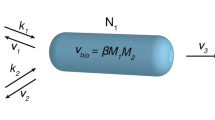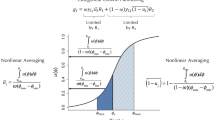Abstract
During the last two decades, the simple view of resource limitation by a single resource has been changed due to the realization that co-limitation by multiple resources is often an important determinant of species growth. Hence, the multiple resource limitation hypothesis needs to be taken into account, when communities of species competing for resources are considered. We present a multiple species–multiple resource competition model which is based on the concept of synthesizing unit to formulate the growth rates of species competing for interactive essential resources. Using this model, we demonstrate that a more mechanistic explanation of interactive effects of co-limitation may lead to the known complex dynamics including nonequilibrium states as oscillations and chaos. We compare our findings with earlier investigations on biological mechanisms that can predict the outcome of multispecies competition. Moreover, we show that this model yields a periodic state where more species than limiting complementary resources can coexist (supersaturation) in a homogeneous environment. We identify two novel mechanisms, how such a state can emerge: a transcritical bifurcation of a limit cycle and a transition from a heteroclinic cycle. Furthermore, we demonstrate the robustness of the phenomenon of supersaturation when the environmental conditions are varied.









Similar content being viewed by others
References
Allan E, Weisser W, Weigelt A, Roscher C, Fischer M, Hillebrand H (2011) More diverse plant communities have higher functioning over time due to turnover in complementary dominant species. Proc Natl Acad Sci 108(41):17, 034–17, 039
Armstrong R, McGehee R (1980) Competitive exclusion. Am Nat 115(2):151–170
Barton AD, Dutkiewicz S, Flierl G, Bragg J, Follows MJ (2010) Patterns of diversity in marine phytoplankton. Science 327(5972):1509–1511
Bastine D, Feudel U (2010) Inhomogeneous dominance patterns of competing phytoplankton groups in the wake of an island. Nonlinear Process Geophys 17:715–731
Bracco A, Provenzale A, Scheuring I (2000) Mesoscale vortices and the paradox of the plankton. Proc R Soc B Biol Sci 267(1454):1795–1800
Doedel EJ, Kooi BW, v Voorn GAK, Kuznetzov YA (2008) Continuation of connecting orbits in 3D-ODES: (I) point-to-cycle connections. Int J Bifurcation and Chaos 18:1889–1903
Doedel EJ, Kooi BW, v Voorn GAK, Kuznetzov YA (2009) Continuation of connecting orbits in 3D-ODES: (II) cycle-to-cycle connections. Int J Bifurcation and Chaos 19:159–169
Droop MR (1973) Some thoughts on nutrient limitation in algae. J Phycol 9:264–272
Droop MR (1974) The nutrient status of algal cells in continuous culture. J Mar Biol Assoc U K 54:825–855
Elser JJ, Borer E, Bracken MES, Cleland EE, Gruner DS, Harpole WS, Hillebrand H, Ngai JT, Seabloom EW, Shurin JB, Smith JE (2007) Global analysis of nitrogen and phosphorus limitation of primary producers in freshwater, marine, and terrestrial ecosystems. Ecol Lett 10:1135–1142
Fussmann GF, Blasius B (2005) Community response to enrichment is highly sensitive to model structure. Biol Lett 1(1):9–12
Gleeson S K, Tilman D (1992) Plant allocation and the multiple limitation hypothesis. Am Nat 139(6):1322–1343
Gross T, Ebenhöh W, Feudel U (2004) Enrichment and foodchain stability: the impact of different functional forms. J Theor Biol 227:349–358
Grover JP (1997) Resource competition. UK, London
Hardin G (1960) The competitive exclusion principle. Science 131 (3409):1292–1297
Harpole WS, Ngai JT, Cleland EE, Seabloom EW, Borer E, Bracken MES, Elser JJ, Gruner DS, Hillebrand H, Shurin JB, Smith JE (2011) Nutrient co-limitation of primary producer communities. Ecol Lett 14:852–862
Huisman J, Weissing FJ (1999) Biodiversity of plankton by species oscillations and chaos. Nature 402:407–410
Huisman J, Weissing FJ (2000) Coexistence and resource competition. Nature 407:694
Huisman J, Weissing FJ (2001a) Biological conditions for oscillations and chaos generated by multispecies competitions. Ecology 82:2682–2695
Huisman J, Weissing FJ (2001b) Fundamental unpredictability of multispecies competition. Am Nat 157(5):488–494
Huisman J, Weissing FJ (2002) Oscillations and chaos generated by competition for interactively essential resources. Ecol Res 17:175–181
Hutchinson GE (1961) The paradox of plankton. Am Nat 95(882):137–145
Kooi BW, Boer MP, Kooijman SALM (1999) Resistance of a food chain to invasion by a top predator. Math Biosci 157:217–236
Kooi BW, Kuijper LDJ, Kooijman SALM (2004) Consequences of symbiosis for food web dynamics. J Math Biol 49:227–271
Kooi BW, Dutta PS, Feudel U (2013) Resource competition: a bifurcation theory approach. Math Model Nat Phenom 8(6):165–185
Kooijman SALM (1998) The synthesizing unit as model for the stoichiometric fusion and branching of metabolic fluxes. Biophys Chem 73:179–188
Kooijman SALM (2010) Dynamic energy budget theory for metabolic organisation, 3rd edn. Cambridge University Press, Cambridge
Kooijman SALM, Andersen T, Kooi BW (2004) Dynamic energy budget representations of stoichiometric constraints on population dynamics. Ecology 85(5):1230–1243
Liebig JV (1840) Die organische Chemie in ihrer Anwendung auf Agrikultur und Physiologie. Friedrich Vieweg, Braunschweig
Loreau M (1998) Separating sampling and other effects in biodiversity experiments. Oikos 82(3):600–602
Muller EB, Nisbet RM, Kooijman SALM, Elser JJ, McCauley E (2001) Stoichiometric food quality and herbivore dynamics. Ecol Lett 4:519–529
Nisbet RM, Muller EB, Lika K, Kooijman SALM (2000) From molecules to ecosystems through dynamic energy budget models. J Anim Ecol 69:913–926
O’Brien WJ (1974) The dynamics of nutrient limitation of phytoplankton algae: a model reconsidered. Ecology 55(1):135–141
O’Neill RV, DeAngelis DL, Pastor JJ, Jackson BJ, Post WM (1989) Multiple nutrient limitations in ecological models. Ecol Model 46(3–4):147–163
Poggiale JC, Baklouti M, Queguiner B, Kooijman SALM (2010) How far details are important in ecosystem modelling: the case of multi-limiting nutrients in phytoplankton - zooplankton interactions. Philos Trans Royal Soc B: Biol Sci 365(1557):3495–3507
Revilla TA, Weissing FJ (2008) Nonequilibrium coexistence in a competition model with nutrient storage. Ecology 89:865–877
Schippers P, Verschoor AM, Vos M, Mooij WM (2001) Does “supersaturated coexistence” resolve the “paradox of the plankton”?. Ecol Lett 4(5):404–407
Shoresh N, Hegreness M, Kishony R (2008) Evolution exacerbates the paradox of the plankton. Proc Natl Acad Sci 105(34):12365–12369
Sommer U (1984) The paradox of the plankton: fluctuations of phosphorus availability maintain diversity of phytoplankton in flow-through cultures. Limonology and Oceanography 29:633–636
Sommer U (1999) Competition and coexistence. Nature 402:366–367
Sperfeld E, Martin-Creuzburg D, Wacker A (2012) Multiple resource limitation theory applied to herbivorous consumers: Liebig’s minimum rule vs. interactive co-limitation. Ecol Lett 15:142–150
Tilman D (1982) Resource competition and community structure. Princeton University Press, Princeton
Wilson JB (1988) The effect of initial advantage on the course of plant competition. Oikos 51:19–24
Wood SN, Thomas MB (1999) Supersensitivity to structure in biological models. Proc R Soc B Biol Sci 266(1419):565–570
Acknowledgments
One of the authors (P.S.D) thanks the Alexander von Humboldt Foundation for financial support in the form of a postdoctoral fellowship. U.F. thanks R. Roy and his group for their hospitality and the Burgers Program for Fluid Dynamics at the University of Maryland at College Park for financial support. The authors acknowledge valuable discussion with Helmut Hillebrand, Bas Kooijman, and Roger Nisbet.
Author information
Authors and Affiliations
Corresponding author
Appendices
Appendix 1: SU rule for k resources
In a homogeneous environment, the arrival fluxes J j are proportional to the concentrations R j of resources X j and n j J m are proportional to the half-saturation constants K ji for species Y i . Scaling J m = 1 as in Eq. 1, the SU rule for multiple (say k) limiting (interactive essential or complementary) resources for species Y i can be written as follows (Muller et al. 2001; Kooijman et al. 2004; Kooijman 2010):
Appendix 2: Parameter values used in our simulations
Online Appendix–III: Time series for different parameter values of three species competing for three resources
Competition between three species (labeled as 1, 2 and 3 in (a) for three essential resources. (a) Competitive exclusion where the winner is depending upon the initial conditions, (b) species oscillations leading to a heteroclinic cycle, (c) species oscillations leading to a limit cycle, and (d) stable equilibrium coexistence of all the competing species. The parameter values are given in Table 2 in Appendix 2
Rights and permissions
About this article
Cite this article
Dutta, P.S., Kooi, B.W. & Feudel, U. Multiple resource limitation: nonequilibrium coexistence of species in a competition model using a synthesizing unit. Theor Ecol 7, 407–421 (2014). https://doi.org/10.1007/s12080-014-0228-6
Received:
Accepted:
Published:
Issue Date:
DOI: https://doi.org/10.1007/s12080-014-0228-6





